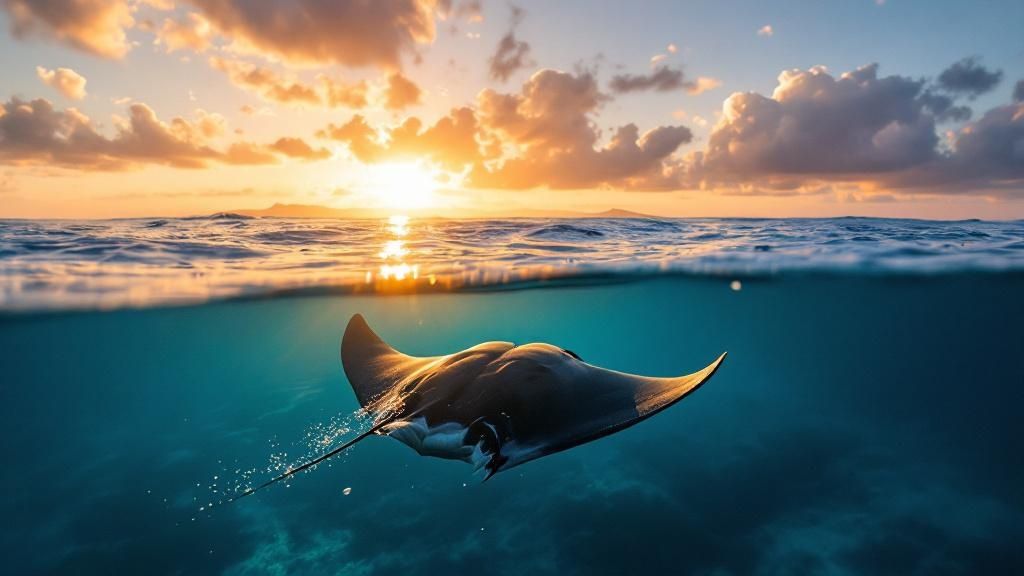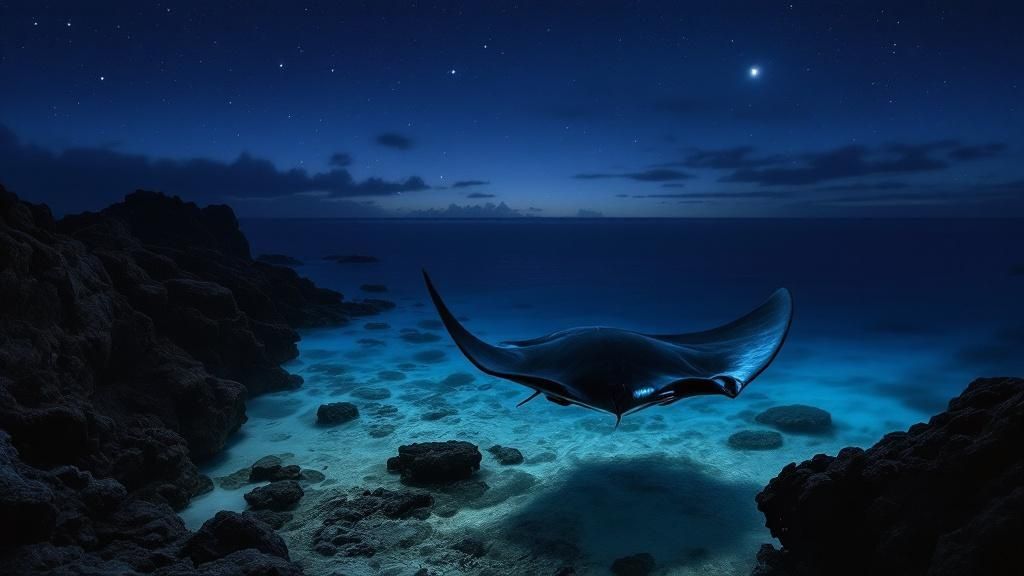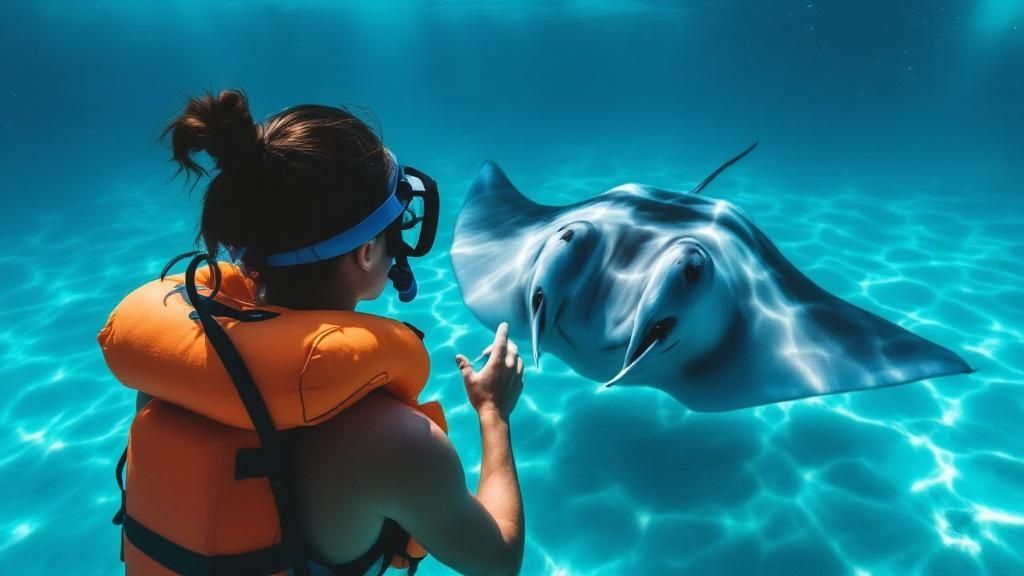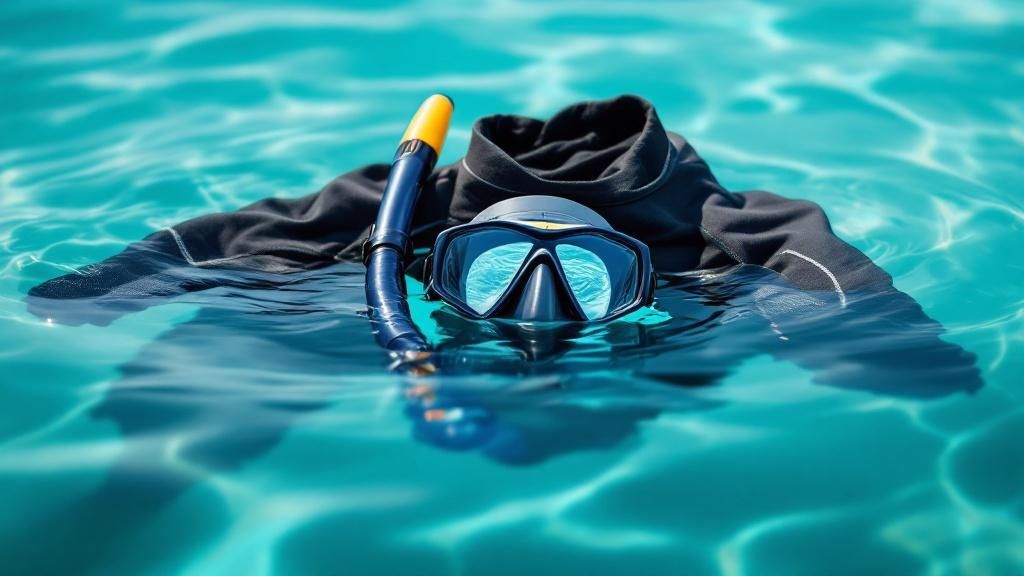Manta Ray Snorkel Kona: Experience Hawaii's NightMagic
- Byron
- Jun 10
- 14 min read
Why Kona Creates The World's Most Magical Manta Encounters
Imagine floating under a blanket of stars in the warm Pacific, a shadow bigger than a car appearing beneath you. This isn't a dream – it's the magic of a manta ray night snorkel in Kona. But what makes this particular coastline a manta ray highway, a dependable gathering spot for these gentle giants? It all comes down to a perfect storm of oceanographic conditions.
The underwater landscape off Kona is like a perfectly designed buffet for manta rays. The Big Island's volcanic slopes create deep underwater canyons and shelves that act like funnels, pushing nutrient-rich currents upwards. These upwellings bring plankton, the manta ray's main food source, closer to the surface. This easy access to a plentiful food supply keeps the mantas coming back for more, night after night.
Light also plays a surprising role. While some plankton naturally floats to the surface at night, the lights from Kona's shoreline enhance this effect. Think of it like moths to a porch light – the lights attract even more plankton, creating concentrated feeding areas. This unintentional creation of ideal dining conditions has made Kona a world-famous manta ray viewing spot. Locations like Manta Village and Manta Heaven, perfectly named for their regular manta ray activity, are prime examples of this phenomenon.
This reliable food source and predictable feeding behavior translate to high manta ray encounter rates in Kona. In fact, manta ray snorkeling in Kona attracts roughly 80,000 people every year, all hoping to see these magnificent creatures in their natural habitat. The incredible sighting success rate, between 80% and 90%, fuels this popularity. Learn more about these magical encounters here: Manta Ray Snorkel Kona: Unforgettable Hawaii Marine Tours
This unique ecosystem arises from a combination of natural and human-influenced factors. Deep ocean currents, packed with nutrients, interact with the volcanic slopes to create upwellings. These upwellings deliver plankton to the surface, where artificial lights further concentrate this food source, drawing the manta rays in for their nightly feast. This predictable pattern makes for reliable viewing opportunities, attracting thousands of visitors to Kona's waters annually. It’s not just luck; it's a beautiful example of the interplay between geology, oceanography, and human influence.

Decoding Kona's Premier Manta Ray Feeding Stations
Not all ocean spots are created equal. In Kona, certain underwater locations transform into nightly dining hotspots for manta rays. These aren't coincidental gatherings; these feeding stations are the result of ingrained manta ray behavior developed over centuries. It's like knowing the best local restaurants – these mantas know where the plankton buffet is consistently open for business. Two locations reign supreme: Manta Village and Manta Heaven.
Manta Village, nestled in Keauhou Bay, is famous for its tranquil, shallow waters and sandy floor. This creates an ideal setting for observing manta rays as they perform their elegant feeding dances. The shallow depth allows light from nearby resorts to filter down, attracting plankton and, consequently, the mantas who feast upon them. This unique blend of natural landscape and human activity is what makes Manta Village so special.
Manta Heaven, a bit further north, also benefits from these light-attracted plankton blooms. However, deeper water and stronger currents distinguish this site. Here, the mantas often display more energetic feeding habits, sometimes performing acrobatic backflips as they filter the plankton-rich water. This site can be a little more challenging for new snorkelers because of the currents, but the reward of witnessing these spectacular displays is worth it for stronger swimmers.
These specific locations are chosen over countless other potential feeding grounds for a few key reasons. Underwater topography plays a vital role. Picture underwater hills and valleys channeling plankton into concentrated pockets. This creates a dependable food supply, attracting mantas like, well, moths to a flame. Plus, the Kona Coast enjoys reliably consistent plankton blooms, further enriching these feeding areas.
The Kona Coast is well-known for its regular manta ray sightings, especially at Manta Village and Manta Heaven. Between 2009 and 2014, detailed records were kept, tracking individual mantas, their health, and their locations. This helped researchers understand the mantas' movements within their home range and predict when sightings would be more frequent. You can discover more insights here.
Tidal conditions also influence these feeding stations. Incoming tides often bring a fresh influx of plankton, providing a more concentrated feast for the manta rays. Experienced manta ray snorkel Kona tour operators understand these patterns and schedule their trips to align with optimal feeding times. This careful planning boosts the chances of unforgettable encounters. If you enjoy marine life and want other ideas like snorkeling with manta rays, consider Whale Watching.
Understanding the specifics of these feeding stations is essential for a genuinely enriching manta ray snorkel experience. By grasping why mantas choose these particular spots, you gain deeper insight into their behavior and the delicate ecosystem they depend on. This knowledge transforms a simple snorkeling trip into a meaningful connection with the natural world.

Navigating Your Perfect Manta Ray Adventure Options
Choosing the right manta ray snorkel tour in Kona can feel a bit like choosing a wine – are you in the mood for a crisp, refreshing Sauvignon Blanc with a small group of friends, or a full-bodied Cabernet Sauvignon shared amongst a larger gathering? With so many options, understanding the subtle differences between each Kona manta ray tour can transform your experience from simply good to absolutely unforgettable. This boils down to considering a few key ingredients: boat size, group dynamics, the guide's expertise, and safety measures.
Choosing the Right Boat and Group Size
Some tours opt for smaller, nimble zodiac boats. Think of them as the sports cars of the ocean, zipping around to the best viewing spots and offering a more intimate, personalized experience with fewer people. These are fantastic for those who crave a closer connection with the water and a touch of adventure. Larger vessels, like catamarans, on the other hand, are more like comfortable SUVs, offering stability and amenities. This makes them a great choice for families or those who might be susceptible to seasickness. It's all about finding the right balance between agility and comfort.
A smaller zodiac, for instance, might hold 6-8 people, allowing for more one-on-one interaction with the guide and a feeling of camaraderie with your fellow snorkelers. A larger catamaran, meanwhile, might accommodate 20+ guests, providing amenities like restrooms and refreshments, but potentially feeling a bit less personal. The sweet spot really depends on what you’re looking for – a close-knit adventure or a more amenity-rich experience. Check out our guide on manta ray snorkel Kona top tours and tips for Hawaii adventures.
Tour Focus: Snorkel-Only, Dive/Snorkel Combo, or Specialty Tours
Think about what you really want out of your time on the water. Do you want to focus solely on snorkeling, or are you interested in a combined dive/snorkel trip? Combo trips can be wonderful for groups with varied interests, allowing divers and snorkelers to experience the magic of the manta rays together. However, this might mean less dedicated time for snorkeling. Some operators also offer specialty tours, like excursions on traditional Hawaiian canoes or tours with a strong emphasis on marine conservation. These unique experiences weave cultural or educational elements into your manta ray encounter.
Budget Versus Premium Experiences: What's the Difference?
Finally, consider your budget. While all manta ray tours aim to create a memorable experience, premium experiences often go the extra mile. Think smaller groups, longer snorkel times, a higher guide-to-guest ratio, and added perks like gourmet snacks and professional photography. Budget-friendly options still offer amazing opportunities to see the manta rays, perhaps with larger groups and fewer extras. Much like choosing a restaurant, selecting the right tour comes down to your personal preferences and how much you’re comfortable spending.

To help you visualize the differences, take a look at this comparison table:
Kona Manta Ray Tour Experience Comparison Essential differences between tour types to help you choose the perfect manta ray adventure for your needs and preferences
Tour Style | Group Size | Duration | Price Range | Best Experience For |
|---|---|---|---|---|
Small Zodiac Boat Tour | 6-8 | 2-3 hours | $$ - $$$ | Adventurous individuals, small groups, personalized experience |
Large Catamaran Tour | 20+ | 3-4 hours | $ - $$ | Families, comfort seekers, those prone to seasickness |
Snorkel-Only Tour | Varies | 2-3 hours | $ - $$$ | Focused snorkeling experience |
Dive/Snorkel Combo Tour | Varies | 3-4 hours | $$ - $$$ | Groups with mixed interests |
Specialty Tour (e.g., Hawaiian Canoe) | Varies | Varies | $$$ - $$$$ | Unique cultural or educational experiences |
The table above summarizes the key differences between the various tour types, highlighting factors like group size, duration, and price range to help you pick the experience that best fits your travel style. Remember, there's no single "best" tour – the perfect manta ray adventure is the one that aligns with your individual preferences and priorities.
Setting Yourself Up For Manta Ray Success
The difference between a so-so manta ray encounter and a truly breathtaking one often comes down to preparation. Think of it like preparing for a big game – you wouldn’t just show up without warming up and strategizing, right? Getting ready for your manta ray adventure involves both mental and physical readiness. We’ll cover everything from easing common anxieties about night swimming to understanding what it's actually like to float above these graceful giants, which can boast wingspans wider than a small car.
Overcoming Common Concerns
It’s perfectly normal to feel a bit apprehensive about night swimming, especially if it's your first time. Imagine stepping into a dimly lit forest – your senses become sharper, and your imagination might start to play tricks on you. But just like a forest walk with an experienced guide, a night snorkel with trained professionals can transform anxiety into awe. Remember, your tour operators prioritize safety and will give you a comprehensive briefing.
One common concern is the cold. Even in warm Hawaiian waters, a wetsuit is key for night snorkeling. It's like wearing a cozy blanket in the ocean! These suits not only provide warmth but also essential buoyancy, making floating effortless. Think of it as your personal, built-in life vest, freeing you to relax and marvel at the show below.
Another worry some people have is motion sickness. If you're prone to seasickness, it's wise to take precautions before setting out. Over-the-counter medications, ginger candies, or acupressure wristbands like Sea-Band can be incredibly effective. Choosing a larger, more stable vessel can also minimize movement, providing a smoother ride. To help you pack smart for your trip, check out these: Top Packing Tips for Travel in 2025.
Understanding The Manta Ray Snorkel Kona Experience
Understanding the setting for your manta ray encounter can also help you mentally prepare. Locations like Manta Village in Keauhou Bay are chosen for their shallow, sandy bottom and typically calm waters. This makes it a great spot for snorkelers of all levels. Knowing this beforehand helps build your confidence and excitement. Discover more insights.
Physically, manta ray snorkeling is surprisingly relaxing. It’s less about strenuous swimming and more about tranquil floating. You’ll be tethered to a flotation device, further reducing any exertion. While you don't need to be an Olympic swimmer, some basic swimming ability is helpful, especially if there’s a gentle current. Visualize yourself lying face down in the water, arms extended, gently kicking your fins. This “superman” position gives you the best view of the mantas gliding beneath.

Preparing for low-light conditions is also important. Underwater lights attract plankton, which in turn draw the manta rays and illuminate them for you. However, your vision will be different than during daytime snorkeling. It’s a bit like stargazing – the darkness enhances the magic. Most tours provide masks and snorkels, but bringing your own comfortable, well-fitting mask can significantly improve your viewing experience.
By addressing these common concerns and understanding the experience, you’ll trade pre-trip jitters for pure excitement, allowing you to fully appreciate the wonder of this incredible wildlife encounter.
Mastering Safety And Respectful Wildlife Encounters
Swimming with manta rays isn't just about staying afloat; it's about respectfully sharing the ocean with these graceful creatures. Think of it like visiting a friend's home – you'd be mindful of their space and house rules. The ocean is the manta rays' home, and we're just visiting. These gentle giants, with wingspans reaching up to 14 feet, deserve our respect. Professional manta ray snorkel Kona operators understand this and prioritize both your safety and the mantas' well-being.
Pre-Dive Briefings: More Than Just the Basics
Before you even get wet, you'll participate in a pre-dive briefing. This isn't just a quick snorkel lesson; it's "Manta Ray 101" combined with essential ocean safety. You'll learn about manta ray behavior, ideal viewing positions, and what to do if you encounter other marine life. It’s like a cheat sheet for navigating the nighttime ocean, covering everything from basic snorkeling to emergency procedures.
Communication is Key: Staying Connected in the Dark
Imagine trying to find your way around a dark room – communication is crucial. In the open ocean at night, it's even more important. Tour operators use communication systems, like waterproof radios and hand signals, to keep everyone connected. This allows guides to address concerns, share manta ray sightings, and coordinate the group. It's like having a direct line to your support team, ensuring you feel secure and can focus on the underwater magic.
Respectful Interaction: The Golden Rule of Manta Ray Encounters
Interacting with manta rays is a privilege. Just as you wouldn't disrupt someone's home, we must respect the mantas' natural environment. You might be interested in: this post about manta ray snorkel Kona experiences. Guidelines like maintaining a safe distance, avoiding sudden movements, and never touching the mantas are essential. This minimizes stress on the animals, allowing them to continue their natural feeding behaviors undisturbed.
Experienced Guides: Your Guardians of the Night
Experienced guides are your allies in the water. They're more than just snorkel instructors; they're experts in reading weather patterns, understanding group dynamics, and making real-time decisions to ensure everyone’s safety. They're like seasoned navigators, constantly assessing the environment and adapting to changing conditions. This expertise creates the best possible experience while prioritizing safety.
Responsible Wildlife Viewing: Protecting the Magic for Generations
Responsible wildlife viewing is at the heart of these tours. It's about protecting both you and the manta rays. By following established protocols and working with marine conservation experts, tour operators ensure the long-term health of this incredible ecosystem. This safeguards the magic of these encounters for future generations.
To illustrate these principles further, let's delve into some specific do's and don'ts. The following table summarizes essential guidelines for interacting with manta rays.
Essential Manta Ray Interaction Protocol
Recommended Action | Avoid Completely | Why It Matters | Impact On Experience |
|---|---|---|---|
Maintain a safe distance (10 feet) | Touching or chasing mantas | Allows mantas to feed naturally without stress | Enhances observation of natural behaviors |
Move slowly and predictably | Sudden movements or loud noises | Prevents startling the mantas | Creates a calmer, more intimate encounter |
Stay with your group and guide | Wandering off alone | Ensures your safety and minimizes disturbance | Maximizes viewing opportunities and learning |
Observe passively; let the mantas approach you | Attempting to ride or interact directly | Respects their wild nature and minimizes stress | Creates more authentic and magical moments |
Use only approved lights (provided by the tour) | Flash photography or bright personal lights | Minimizes disruption to their natural environment | Allows for better viewing and photography with provided lighting |
This table highlights how respecting these guidelines creates a more rewarding experience. Remember, observing these gentle giants is a privilege. Respectful interaction ensures their well-being and preserves this magical experience for years to come.
Timing Your Adventure For Maximum Magic
Like any wildlife encounter, timing is key for a truly magical manta ray snorkel Kona experience. The "best" time isn't simply about when the mantas are most active; it's about finding the sweet spot between ideal conditions, manageable crowds, and what works best for you. Think of it like planning the perfect beach day – you want sunshine, calm waters, and enough space to spread out your towel. Let's break down the factors that influence both manta ray behavior and tour operations.
Moon Phases and Manta Ray Feeding
The moon plays a surprisingly large role in the manta ray feeding schedule. A full moon brightens the underwater world, attracting plankton to the surface like moths to a porch light. This, in turn, draws the manta rays in for a feast, especially around popular spots like Manta Village and Manta Heaven. However, a new moon, with its inky darkness, can be just as enchanting. The mantas become more active hunters, seeking out plankton in the shadows.
This doesn't mean you won't see mantas during other moon phases, just that the behavior might be slightly different.
Seasonal Patterns: Calm Seas Versus Sightings
Just like choosing a vacation destination, certain months offer calmer seas but potentially fewer manta sightings. Summer, particularly June through September, is typically known for its tranquil waters, making for easy snorkeling. However, due to shifting ocean currents, plankton may be less abundant during these months, potentially leading to fewer manta ray encounters.
Winter, on the other hand, can bring rougher seas but the increased plankton blooms often mean more manta ray activity. It's a bit like choosing between a calm lake and a lively ocean – both have their own unique charm.
Weather Patterns, Plankton, and Manta Behavior
Weather adds another layer of complexity to this intricate dance. Rain, for instance, washes nutrients from the land into the ocean, sometimes boosting plankton growth. This creates a richer buffet for the manta rays, potentially leading to more energetic and exciting interactions. Water temperature changes can also affect plankton distribution, further influencing manta ray movements.
It’s all interconnected!
Booking Strategies for Peak Seasons
Peak tourist seasons, like popular holidays, often mean higher prices and more crowded tours. But don't worry, you can still find a fantastic manta ray snorkel Kona experience without emptying your wallet. Booking in advance, especially during the busy season from December through February, is a must.
Consider traveling during the shoulder seasons (April-May or September-October) for a pleasant balance of good weather, fewer crowds, and potentially better deals. When considering safety for your manta ray snorkel Kona trip, a reliable marine radio like the Cobra HH350 Floating Marine Radio can provide added peace of mind.
Flexibility and the Magic of Unpredictability
Finally, be prepared to embrace the unexpected. While planning and preparation are important, wildlife encounters are inherently unpredictable. Being flexible with your itinerary can dramatically increase your chances of a truly magical experience. Sometimes, the most memorable moments happen when you least expect them, perhaps on a night with a less-than-ideal moon phase or during slightly choppier water. It's the spontaneity that makes these experiences so special.
By understanding these factors and planning thoughtfully, you'll be well on your way to an unforgettable manta ray encounter – a night of pure wonder under the Hawaiian stars.
Becoming Part of the Conservation Story
Your manta ray snorkel Kona adventure is more than just a magical evening; it's a chance to contribute to a real conservation success story. These gentle giants face challenges, from boat strikes and fishing gear entanglement to the effects of climate change on their food sources. But responsible tourism, like the tour you're taking, directly supports vital research and protection efforts.
This means your tour fee isn't just covering the boat and snorkel gear. It's fueling important scientific studies that help protect these incredible creatures. Think of photo identification projects, for example, which track individual mantas. This allows researchers to monitor their movements, health, and population over time. Research into their feeding habits and overall population health also gives us valuable clues on how to best safeguard their fragile ecosystem. Want a deeper dive into manta ray encounters? Check out our complete guide: Manta Ray Snorkel Kona: Complete Guide to Magical Encounters
The Remarkable Recovery of Hawaii's Manta Rays
The story of Hawaii's manta rays is one of hope and resilience. Thanks to dedicated scientists, responsible tour operators, and involved local communities, these gentle giants have made an impressive comeback. Their recovery demonstrates the real power of sustainable wildlife tourism. It's a strong example of how tourism can be a positive force for marine life protection around the world.
Extending Your Impact Beyond Your Snorkel
Your contribution to manta ray conservation doesn't have to stop when you leave the boat. There are plenty of ways to continue making a difference. Supporting marine conservation groups, choosing sustainable travel options that protect ocean ecosystems, and spreading the word about responsible wildlife tourism are all great ways to get involved. Imagine it like ripples in a pond—even small actions can create a bigger wave of positive change.
Hearing From the Researchers
Learning directly from the researchers whose work your visit supports adds a very personal touch to the experience. Their stories show the real impact of sustainable tourism. They highlight how your participation directly helps protect these amazing animals. This connection transforms your snorkeling trip from a simple tourist activity into something truly meaningful. It’s a powerful reminder that we all have a role to play in protecting the wonders of our oceans.
Book your unforgettable manta ray night snorkel adventure with us today at Manta Ray Night Snorkel Hawaii and become a part of this important conservation story.
Comments